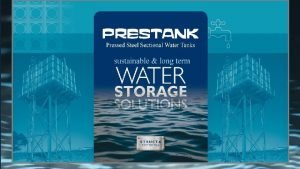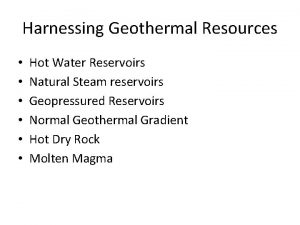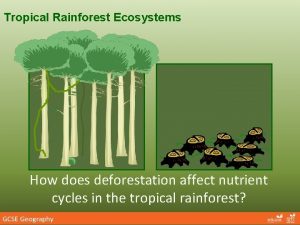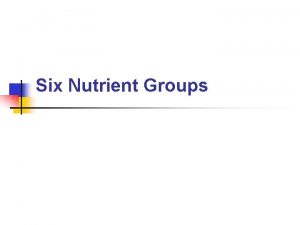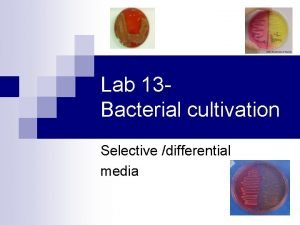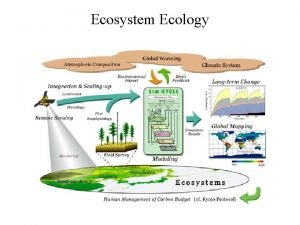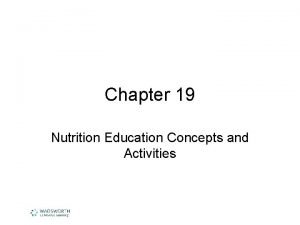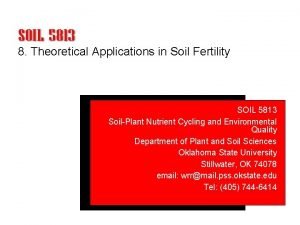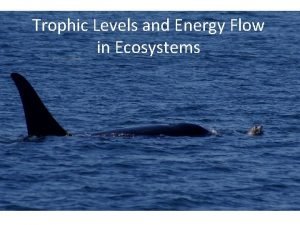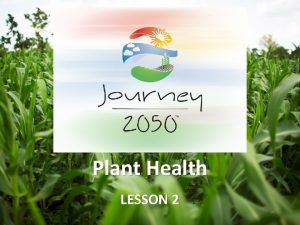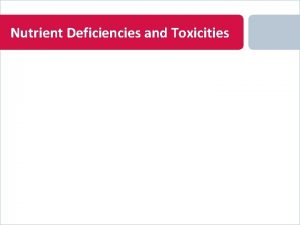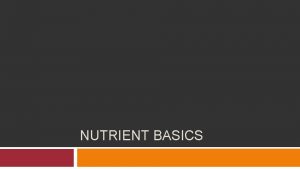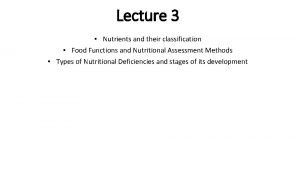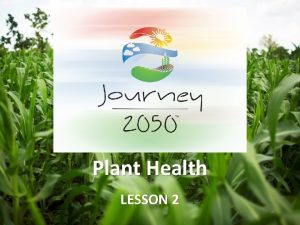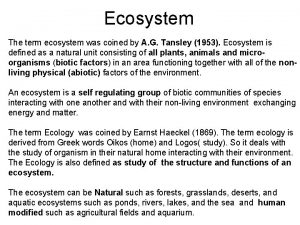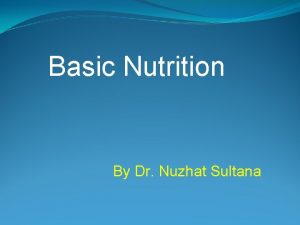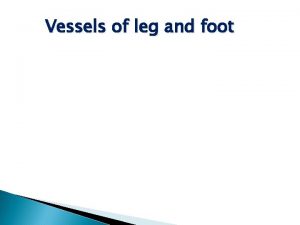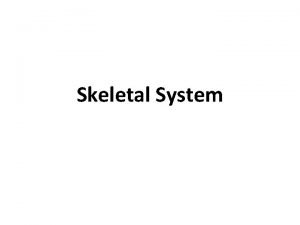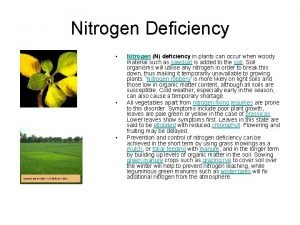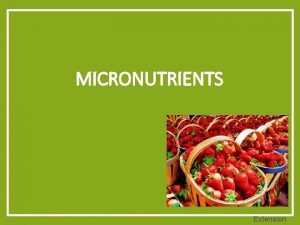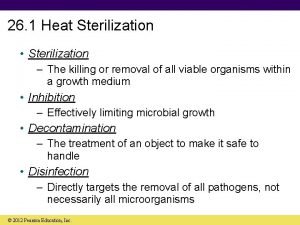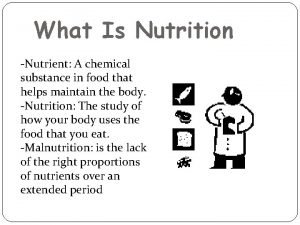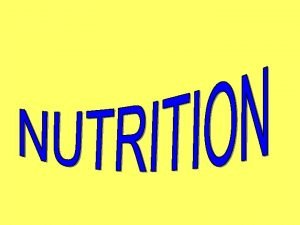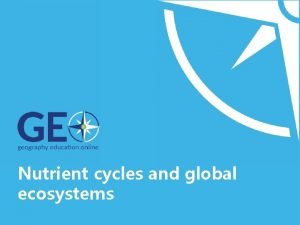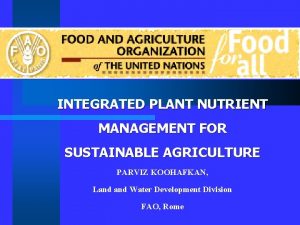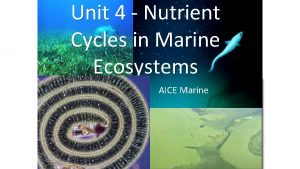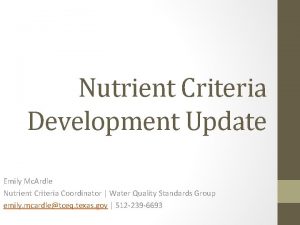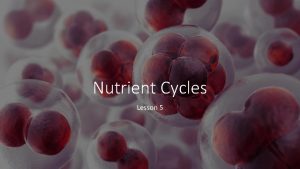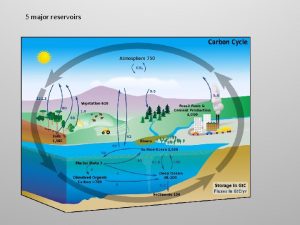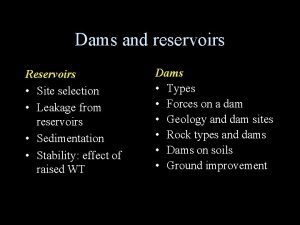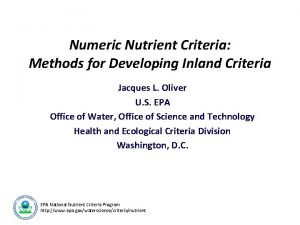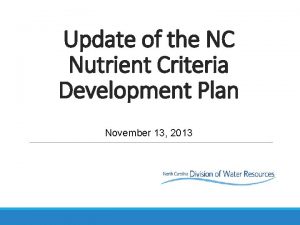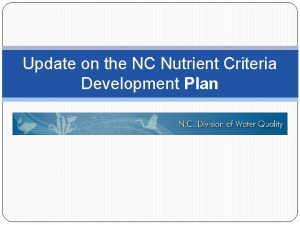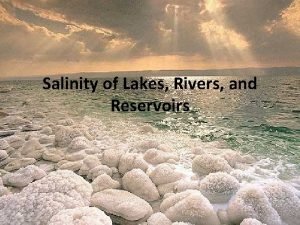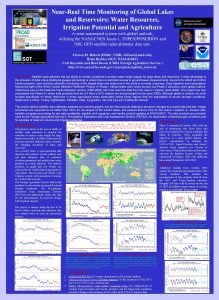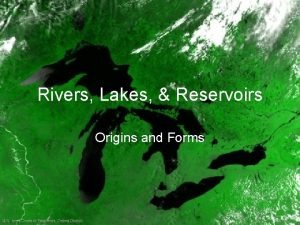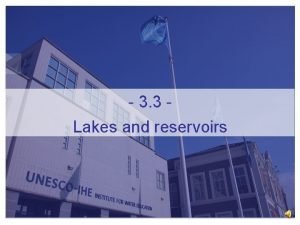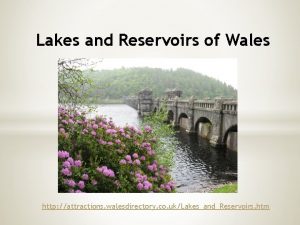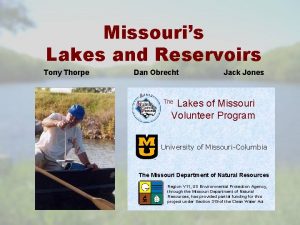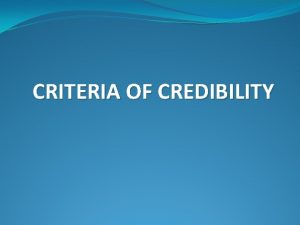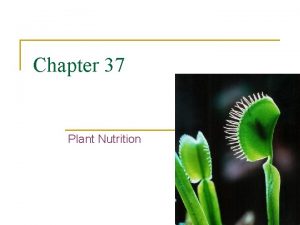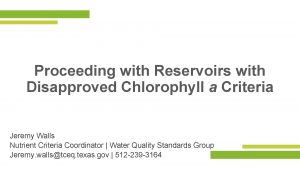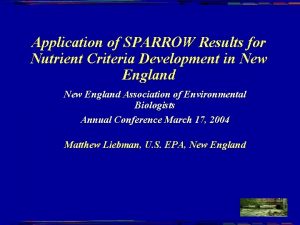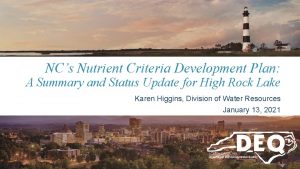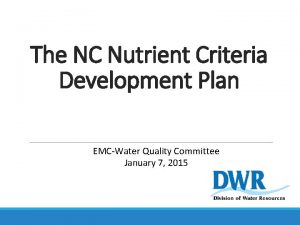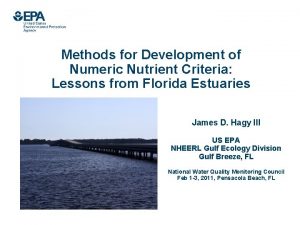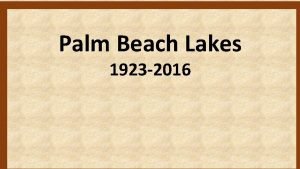AZ Lakes Reservoirs Nutrient Criteria Development Update Status







![EPA Approach [Here you go… OR, develop your own! ] P. S. EPA must EPA Approach [Here you go… OR, develop your own! ] P. S. EPA must](https://slidetodoc.com/presentation_image_h2/8569d3b544d8028efbe58cfddf216839/image-8.jpg)






























- Slides: 38

AZ Lakes & Reservoirs Nutrient Criteria Development Update Status and Projections Susan Fitch, ADEQ 602 -771 -4541 Fitch. susan@azdeq. gov

Presentation: • Regulatory Background (standards, assessment, permitting) • Derivation of nutrient criteria (EPA vs AZ approach) • Pilot test: Interpretation of the standard for assessment – (8/2008 – 1/2009) • Added to AZ Surface Water Quality Standards in January 2009. . application to CWA programs pending EPA approval • EPA review 2010 -2011; not yet approved • EPA issues • ADEQ plan for 2012 • Ongoing challenges and future work

Regulatory Framework �Environmental Protection �Water Quality Criteria �Monitoring �Assessment �Permitting �TMDL �Environmental Restoration

Nutrient Criteria Why do we need them?

Problems with “excess” nutrients �Imbalance. . � “Excess” algae/plants � Aesthetics � Toxicity/health effects � Taste & odor problems � Low dissolved oxygen � Ecological diversity � Ecological sustainability � Habitat degradation � Recreational safety

Background �Two phases of previous numeric nutrient criteria � 1972: EPA assigned criteria to the Colorado River and its tributaries as part of the Clean Water Act (criteria were expressed as phosphate and nitrate; now de-promulgated) � 1981/1982 AZ Water Board ran statistics on USGS data from streams; set nutrient endpoints for Total N and Total P; main reservoir systems also given criteria (stream nos. remain unless EPA allows us to substitute the new lake standards and continue do develop stream criteria) � 2002: Lakes, as integrators of watershed activities, seemed a logical first forum for lake type/ecosystem-based biomass endpoints with nutrients as secondary criteria

Background • 1998 Clean Water Act Initiative – led EPA to derive numeric nutrient standards for lakes (and streams) that are based on aggregated level III ecoregions; in AZ, that meant two: AZ/NM Mountains and Xeric SW – 2000 - 2002 EPA Ecoregional Criteria • EPA only looked at a handful of AZ lakes/data that were in STORET; issue of timing - AZ had just set up the WQDB and had not yet uploaded most lake data into STORET • EPA criteria for are ONE SIZE FITS ALL and would apply to all lakes equally (and all perennial streams equally) • 2002 AZ recognized that one size does NOT fit all (4 shallow lake TMDLs and Lakeside Lake TMDL with effluent) • AZ Goal: to derive protective narrative nutrient endpoints that considered lake type (size, average depth, source water, hydrology, morphology, setting, end uses) and other watershed characteristics or lake characteristics that were statistically linked
![EPA Approach Here you go OR develop your own P S EPA must EPA Approach [Here you go… OR, develop your own! ] P. S. EPA must](https://slidetodoc.com/presentation_image_h2/8569d3b544d8028efbe58cfddf216839/image-8.jpg)
EPA Approach [Here you go… OR, develop your own! ] P. S. EPA must approve or default will kick in

USEPA’s default criteria are ecoregional…

EPA’s National Nutrient Criteria (based on 25 th percentile of all data/all seasons) � Aggregate Ecoregion II (AZ/NM Mountains lakes): � TP (mg/L): 0. 009 � TN (mg/L): 0. 10 � Chl-a (ug/L): 1. 9 � Secchi (m): 4. 5 � Aggregate Ecoregion III (remainder of AZ lakes) � TP (mg/L): 0. 017 � TN (mg/L): 0. 40 � TKN (mg/L): 0. 30 � Chl-a (ug/L): 3. 5 � Secchi (m): 2. 8 �AZ - very few included � data in STORET in 1999 �AZ – very few included � data in STORET in 1999 �All numbers VERY low!

AZ Approach [ok, here WE go. . and may the EPA gods bless us with approval !] OR. . ELSE P. S. YOU DON’T WANT THAT TO HAPPEN

AZ Narrative Nutrient Standard �R 18 -11 -108 A. A surface water shall be free from pollutants (nutrients in this case) in amounts that: � Settle to form bottom deposits that inhibit or prohibit the habitation, growth, or propagation of aquatic life; � Cause objectionable odor in the area in which the surface water is located; � Cause off-taste or odor in drinking water; � Cause off-flavor in aquatic organisms; � Are toxic to humans, animals, plants, or other organisms; � Cause the growth of algae or aquatic plants that inhibit or prohibit the habitation or other aquatic life or that impair recreational uses; � Cause or contribute to a violation of an aquifer water quality standard…; � Change the color of the surface water from natural background levels

Criteria considerations �Numeric nutrient criteria alone will not tell you about the health of a lake system �Numeric targets likely to vary between lake categories � e. g. , some types of lakes “expected” to be more productive, less clear than others �Implementation procedures must address potential conflicts between multiple uses � e. g. , warm water fishery v. recreation or domestic water source �Implementation procedures should allow consideration of non-numeric � e. g. , fish community assessment, user complaints

AZ Approach � Discussed joining Region 9 effort (spearheaded by Tetra Tech) � Concluded AZ would pursue an empirical tack, rather than modeling � Lakes Program compiled all ADEQ database lake data (1990 -2003) � 2003 Hired Malcolm Pirnie (Clifton Bell) - Stoneman Lake TMDL � Additional data from about 15 lakes in late 2003 to increase the data set; MP added data from Lake Powell (UT) and Lake Mead (NV) - Total number of lakes was 70; 52 met data requirements (included most large AZ reservoirs) � Focus parameters : total nitrogen (TN), total phosphorus (TP), nitrate-N, total Kieldahl nitrogen (TKN), ammonia (NH 3), secchi depth, chlorophyll, algae ID, DO, p. H, alkalinity, TSS, turbidity etc. � Wanted to add organic carbon, but did not have enough data at that time

AZ Approach cont. � Link causal and response variables for AZ lakes and reservoirs � Approach: to run statistics on various water quality parameters as related to chlor-a, plus water quality parameters as related to various GIS-based watershed characteristics � 70 lakes and their watersheds were digitized in Arc. GIS and various covers were clipped to those watersheds (geology, soils, land use, vegetation, etc. ) � level III ecoregions (all 6, not just the 2 aggregates) were considered, as were climatological attributes, hydrologic regime/water retention time, watershed: lake size, elevation, etc) � Statistics: descriptive, bivariate correlations, regression, Principle Components Analysis, and Classification and Regression Tree

Most Important Variables � Setting � Geology/Soils � Elevation � Hydraulic Retention Time/Flushing � Lake Morphology; Max & Avg depth & Stratification Index � Internal Nutrient Cycle *[NOT Ecoregions]

Initial Data Analysis �PROs: � Chlorophyll levels linked with TKN & Cyanophyte counts (R 2 0. 6) � Large reservoirs show longitudinal gradient; small-medium lakes/reservoirs more uniform � Dissolved oxygen profile strongly linked to available (dissolved) nutrients and metals �CONs: � Secchi depth confounded by mineral particulates � Other nutrients and secchi depth not as strongly linked (R 2 0. 35) �Questions: � Nutrient values related to chlorophyll quite a bit higher than EPA predicted. . Need to test with more data � Chlorophyll enough by itself? Counts? Biovolume? � Need other parameters? ; need more data?

Never-the-less. . AZ Classes of Lakes � ‘Deep” lakes fell out based on size, morphology, projected hydraulic retention time, and trophic status. . Need depth categories � “Shallow” lakes fell out based on average depth, low - moderate chlorophyll-a and the tendency toward macrophyte (SAV) domination � “Igneous” lakes fell out based on the predominant geology and soils; abundance of suspended clay particles limits light as well as carry higher nutrients (TP & TKN) into the system � “Sedimentary” lakes were a combination of those found in karst geology and sedimentary geology. . . Need further refinement � “Urban” lakes were separated out based on setting and regulatory allowances (physical and chemical treatment); they are typically small, shallow, more stagnant, and need intensive management

Comparison of EPA Criteria to AZ Criteria EPA instructed states to develop their own criteria and encouraged setting biological endpoints (e. g. , chlorophyll-a)… Trophic Parameters Chlor-a ug/L Secchi m TP ug/L TN mg/L TKN* mg/L Ecoregion AZ/NM 25% Ecoregion Xeric 25% AZ Deep 25 % AZ Shallow 25 % AZ Igneous 25 % AZ Sedimentary 25 % AZ Urban 25 % AZ TSI 25% 1. 9 1. 8 2. 02 4. 84 9. 24 1. 35 7. 45 1. 85 4. 5 2. 8 5. 2 1. 84 1. 72 2. 46 1. 17 2. 75 9 17 56 49 77 16 37 32 0. 10 0. 4 0. 62 0. 86 1. 42 0. 65 0. 95 0. 75 NA NA 0. 43 0. 83 0. 95 0. 6 0. 95 0. 5 *NOTE: Chlor-a and Secchi are similar, but nutrients are higher

AZ Chlorophyll-a All lakes: n=906 samples 1000, 00 301, 00 100, 00 26, 70 ug/L 9, 58 10, 00 3, 74 1, 54 1, 00 0, 75 0, 10 0, 04 0, 01 max 90. 0% 75. 0% 50. 0% Distribution 25. 0% 10. 0% min

Resultng AZ Trophic Index Chlorophyll-a Secchi Depth Tot. al Phosphorus Total Nitrogen TKN (ug/L) (m) (ug/L) (mg/L) 0. 3 5. 2 13 0. 5 0. 3 0. 6 4 19 0. 6 0. 3 1. 2 3. 1 27 0. 4 2. 5 2. 4 37 0. 8 0. 6 5 1. 8 52 1 0. 7 10 1. 4 74 1. 2 1 20 1. 1 103 1. 5 1. 2 70 40 0. 8 145 1. 8 1. 6 80 81 0. 6 203 2. 2 2. 1 161 0. 5 285 2. 7 323 0. 4 400 3. 3 3. 5 TSI Score TSI Category 0 10 Oligotrophic 20 30 Mesotrophic 40 50 60 90 100 Eutrophic Hypereutrophic

Original TSI (Florida) TSI < 30 Clor-a <5 3045 5 -12 4565 12 -20 >65 >20 Secchi (m) >3 1. 2 -3 0. 6 -1. 2 <0. 6 Total P (mg/L) P-lim Co-lim Total N (mg/L) N-lim Co-lim <. 010 <. 25 <. 013 . 010. 020 . 013. 035 . 25 -. 65 . 020. 040 . 035. 065 . 65 -1. 1 >. 040 >. 065 >1. 1 vs. Revised TSI (Arizona) TSI Chlor-a (ug/L) Secchi (m) Total-P (mg/L) Total N (mg/L) TKN (mg/L) 0 0. 3 5. 2 0. 013 0. 5 0. 3 10 0. 6 4. 0 0. 019 0. 6 0. 3 20 1. 2 3. 1 0. 027 0. 4 30 2. 5 2. 4 0. 037 0. 8 0. 6 40 5. 0 1. 8 0. 052 1. 0 0. 7 50 10 1. 4 0. 074 1. 2 1. 0 60 20 1. 1 0. 103 1. 5 1. 2 70 40 0. 8 0. 145 1. 8 1. 6 80 81 0. 6 0. 203 2. 2 2. 1 90 161 0. 5 0. 285 2. 7 100 323 0. 400 3. 3 3. 5 Still need to account for limitation

Resulting AZ “Matrix” Response Variables Chl-a (ug/L) Secchi Depth (m) Cyanophytes (per m. L) All 10 -20 0. 5 -1. 5 20, 000 Deep 10 -15 Shallow Designated Use DWS FBC or PBC A&Wc A&Ww A&Wedw Cyanophytes (% of total count) Related Variables (causal? ) DO (mg/L) Tot. Phos. (ug/L) Tot. Nit. (mg/L) TKN (mg/L) 70 -100 1. 2 -1. 5 1. 0 -1. 2 1. 5 -2. 5 70 -90 1. 2 -1. 4 1. 0 -1. 1 10 -15 1. 5 -2. 0 70 -90 1. 2 -1. 4 1. 0 -1. 1 Igneous 20 -30 0. 5 -1. 0 100 -125 1. 5 -1. 7 1. 2 -1. 4 Sedimentary 20 -30 1. 5 -2. 0 100 -125 1. 5 -1. 7 1. 2 -1. 4 Urban 20 -30 0. 5 -1. 0 100 -125 1. 5 -1. 7 1. 2 -1. 4 All 5 -15 1. 5 -2. 0 50 -90 1. 0 -1. 4 0. 7 -1. 1 7 top m All except urban 25 -40 0. 8 -1. 0 115 -140 1. 6 -1. 8 1. 3 -1. 6 6 top m Urban 30 -50 0. 7 -1. 0 125 -160 1. 7 -1. 9 1. 4 -1. 7 All 30 -50 0. 7 -1. 0 125 -160 1. 7 -1. 9 1. 4 -1. 7 20, 000 <50 p. H (SU) 5. 0 – 9. 0 6. 5 – 9. 0

Progression of the “Matrix” etc. �Several public meetings (many of you were there!) between 2004 and 2006 �Worked on an implementation plan for application of the “matrix” etc. to assessment and permits �Various delays/various reasons �Goals: �Add to Surface Water Standards �Get EPA approval �Results: �Added to SWS in January 2009 �EPA approval process 2009 -2011. . Resulted in Region 9 support but lack of approval from EPA Headquarters

Major EPA Issues: Defensibility �Clarify how ranges of endpoints will be used �Are chlorophyll endpoints protective of uses? �Substantiate relationship of nutrients to chlorophyll �Address DO gradient �Define “warm” vs. “cool” vs. “cold” water fishery

In the meantime: 2008 Test of Matrix What makes sense, what doesn’t

Pilot Matrix/TSI Evaluation • Going back to the data synopsis MP did for us as of 2003, we listed all lakes and what data we had collected since then, as of August 2008. . • Downloaded data from 10 deep lakes, 15 Igneous lakes, 4 sedimentary lakes, 6 shallow lakes, and 6 urban lakes (+TTL) = 42 lakes total (some updates, some reruns – Field Data: temp, DO, p. H & secchi – Lab Data: TKN, TP, nitrate, ammonia, chlorophyll-a • Only used peak season data • April-October (warm water) ; May-September (cold water) • Let’s look at one example: Alamo Lake

Alamo Lake Thresholds Class: Deep Elev 1235 % hypox Site DEQ 70% FBC 1. 5 to 2. 5 A&W 0. 8 to 1. 0 Means 1. 1 TSI 59 Depth Date m Temp C A . 1 9/03 27. 94 A 1 27. 54 A 2 A Secchi m 6 6. 5 to 9 1. 0 to 1. 1 1. 2 to 1. 4 0. 07 to 0. 09 10 to 15 20, 000 1. 3 to 1. 6 0. 52 1. 62 1. 3 to 1. 6 0. 115 to 0. 140 25 to 40 0. 02 1. 64 0. 58 7. 21 65 111 45 70 DO p. H mg/L SU TKN mg/L NO 3 mg/L Total N mg/L Total P mg/L Chlor-a BG ug/L count 0. 2 1. 15 0. 02 1. 17 0. 018 7. 21 8. 6 6. 45 8. 6 27. 16 6. 39 8. 61 3 26. 98 6. 14 8. 59 A 4 26. 99 6. 04 8. 59 A 5 26. 96 5. 94 8. 6 A 8 21. 5 0. 23 7. 4 0. 15 1. 3 0. 02 1. 32 0. 042 A 17 15. 45 0. 14 7. 22 1. 1 2. 26 0. 01 2. 27 0. 163 A 22. 3 15. 37 Means 0. 13 1. 1 105, 546 96. 02 NH 3 mg/L 6. 47 1. 1 < 50 105, 546 96. 02 7. 12 0. 52 1. 62 0. 02 1. 64 BG % total 0. 58 Summary: Chlor-a OK. Lake 10 m below desired pool; TSI scores for TKN and TP show abundant nutrients; mean TKN slightly above threshold but TKN, TP & ammonia at depth driven by 70% hypoxia in hypolimnion; BG very high. Inconclusive; Planning List

2008 TSI Scoring Worksheet cold water (>5500 ft): May-September warm water (<5500 ft): April-October Lake Name Site Code Alamo Lake BWALA-A Year 2003; 2004; 2005; 2006 same shallow deep Saguaro data Mean Mean TSI Secchi SD TSI Total P TP TSI Total N TN TSI TKN 1. 92 38. 15 7. 21 2. 71 4. 13 45. 25 31. 16 37. 22 1. 1 1. 35 2. 43 1. 01 16. 94 3. 76 35. 87 all 8. 27 47. 22 all 7. 82 46. 42 1. 31 1. 6 all 7. 74 46. 27 SRSAG-A, B, C 1995 -2002 fire all Post fire SRSAG-A, B, C 2003 -2007 all 3. 4 SRROO-A, B, C 1992 -2002 fire all Post fire SRROO-A, B, C 2003 -2006 all Canyon data 35. 48 Roosevelt Apache Canyon data 3. 66 BWALA-A Apache data Depth TSI (m) Chlor-ACHLA Alamo Lake Roosevelt data 2003 -9/2004 all 9/2004 -2006 all SRAPA-A, B, C <2003 fire Post fire SRAPA-A, B, C 2003 -2007 SRCAN-A 2001; 2002 fire Post fire SRCAN-A, B 2003 -2007 Bartlett Lake VRBAR-A, B, C 1992 -2002 Bartlett Lake VRBAR-A, B, C 2003 -2006 all 59. 37 51. 57 29. 25 0. 05 0. 13 0. 58 0. 08 0. 70 38. 73 66. 91 111. 03 51. 92 116. 44 0. 71 1. 07 1. 64 0. 87 0. 95 21. 66 42. 66 64. 53 31. 79 36. 39 0. 67 1. 03 1. 62 0. 85 0. 90 35. 74 52. 56 70. 26 44. 85 47. 11 1. 89 38. 75 0. 07 48. 65 0. 65 17. 14 0. 62 32. 71 1. 7 42. 78 0. 03 23. 66 0. 76 25. 15 0. 69 36. 89 0. 12 64. 55 0. 91 34. 37 0. 9 47. 28 52. 71 45. 09 0. 06 0. 05 44. 10 38. 73 0. 81 0. 53 28. 41 6. 69 0. 8 0. 5 42. 68 24. 30 1. 66 43. 69 0. 05 38. 73 0. 77 25. 82 0. 75 40. 15 34. 42 2. 28 31. 60 0. 06 44. 10 0. 65 17. 14 0. 61 32. 07 8. 64 47. 85 1. 86 39. 36 0. 06 44. 10 0. 88 32. 65 0. 84 44. 58 3. 42 5. 94 34. 51 42. 46 2. 54 1. 34 27. 48 51. 85 0. 04 0. 05 32. 14 38. 73 0. 67 0. 73 18. 70 23. 09 0. 63 0. 7 33. 33 37. 45

Data & Data Analysis Issues • Non-detects (assigned the reporting limit; ½ reporting limit)? • We combined lake data from ADEQ, AGFD, USFWS, Uof. A – AGFD doesn’t do a full profile or collect a full suite – USFWS takes a profile reading in increments of 5 m; same for samples…at Alamo and Painted Rocks – Dave Walker (Uof. A) was instructed to use our protocols under an ISA (2002 -present); Roosevelt, Apache, Canyon, Saguaro, Bartlett, Pleasant, Lakeside, Parker Canyon, Arivaca, Pena Blanca, Rose Canyon, Lake Mary, Watson Lake. . – Other? • Standard for comparability in lab methods/detection limits/QC – E. g. , chlor-a data & nutrient data from 4 sources: ACT, Walker (his lab), AGFD (their lab), USFWS (? lab)

Analysis issues • Need to depth-composite chlor-a ? Currently a grab • We considered nutrient data from all depths equally – When stratified, values much higher in hypolimnion, but those nutrients will be available when lakes turns over; weight ? – We included potential turnover months (April/May & Sept/Oct) • Minimum 1 epilimnion & 1 hypolimnion sample for nuts ? • How many years to include? Last 5 - 10 revolving? . . – We did run “before” & “after” (fire) evaluation on the Salt reservoirs • If chlor-a OK, but Cyanophytes or nutrients high, how best to track? • How will we track TSI scores? ; – What constitutes a trend? – What increase triggers what action? – as relates to the Matrix

Analysis issues continued • Algae – Some BG genera potentially toxic (~ half dozen)…need to refine standard to weigh “toxic” vs “nuisance”, more than a straight percentage – How do we monitor effectively for toxins? – Some BG genera are NOT toxic, but may be ubiquitous. . e. g, Spirolina…good for fishery but how about other uses? – The golden algae, Prymnisium parvum and others may be toxic but under what conditions? – Is it possible/desireable to develop an algae IBI in the arid SW with mostly man-made/unnatural lakes & reservoirs? – Algal counts are variable…how to standardize? Biovolume?

How would you count these?

Tools for Tracking Trends � Individual or composite TSI scores: TP, TN, TKN, chlor-a, secchi depth (other) – ind. lake/by lake class/overall? � Hypoxic length: depth of very low oxygen (<2 mg/L) � DO depth gradient: tied to max depth and strength of stratification � Diel DO fluctuation: degree of flux in DO over a 24 -hr period (also diel p. H) � Lake level fluctuations � Fires and other phenomenon (climate change) � Change in algal & other aquatic communities? � A better handle on hydraulic retention/flushing , temperature flux and light attenuation, zooplankton/trophic community & structure in general, fishery goals & evaluation

Associated Parameters Needs: • Percent submerged aquatic vegetation (SAV) – We need to adopt a consistent estimation method – AGFD method but how to evaluate community, aside from invasives – Remote sensing? • Diel DO: swing not greater than 5 mg/L in shallow lakes – We need to familiarize ourselves with the YSI capability and work this into the monitoring schedule when we go to shallow lakes • Hypoxia calculations from the DO profile – Consistency in depth profile measurements – Impacts “refugia” for fish – DO gradient : how much DO drops/meter – Oxydation vs. Reduction: mobilization of nutrients and metals

Synopsis of Issues to Resolve � Agreed upon parameters; commitment to obtaining the data � Consistent field protocols (data quality) � Consistent lab protocols (data quality) � Data accessibility; storage, retrieval; analysis � Update data analysis (with data from 2004 -2011) to test relationships � Finalize Implementation Plan for assessment and permitting � Obtain EPA approval

What’s Ahead, 2012 & Beyond �Goals for 2012 � Update statistics � Update literature search/benchmark other states � Refine lake classes as necessary � Finalize matrix of endpoints for designated uses � Chlorophyll +? � Secchi, what is it? � TKN, TP, TN. . +? � Add carbon � Cyanophytes/toxins � SAV; periphytin? � Trophic response/TSI � Refine DO assessment � Identify additional needs/refinements �Goals for Future �More lakes, more data! �Broader involvement �Collaboration to protect and enhance lakes & reservoirs Help Us Help You!

Next Up: Dr. Walker Limnological Challenges Past & Ongoing Research Potential for Collaboration Thank You!
 Nutrient broth vs nutrient agar
Nutrient broth vs nutrient agar Recovery techniques based on immediate update
Recovery techniques based on immediate update Pressed steel sectional panel water tank
Pressed steel sectional panel water tank Hot water reservoirs
Hot water reservoirs Project status update examples
Project status update examples Fsu freight status update
Fsu freight status update Profunda brachi artery
Profunda brachi artery Nutrient cycle of a tropical rainforest
Nutrient cycle of a tropical rainforest Nnn plant protein
Nnn plant protein Differential media
Differential media Emulsifier egg
Emulsifier egg Nutrient cycle in the serengeti
Nutrient cycle in the serengeti Deciduous woodlands
Deciduous woodlands Foods used in nutrition activities should be nutrient-dense
Foods used in nutrition activities should be nutrient-dense Bray nutrient mobility concept
Bray nutrient mobility concept Energy in trophic levels
Energy in trophic levels Which nutrient practice was best journey 2050
Which nutrient practice was best journey 2050 Iron deficiency in roses
Iron deficiency in roses Nutrient basics
Nutrient basics Classification of macronutrients
Classification of macronutrients How does a plant resist disease and pests journey 2050
How does a plant resist disease and pests journey 2050 Which ecosystem is this nutrient cycle from?
Which ecosystem is this nutrient cycle from? Defination of nutrient
Defination of nutrient Biogeochemical cycles apes
Biogeochemical cycles apes Foot arteries
Foot arteries Skeletal system
Skeletal system Tamoxifen nutrient depletion
Tamoxifen nutrient depletion Nutrient deficiency in tomatoes
Nutrient deficiency in tomatoes Nutrient interactions
Nutrient interactions Immobile nutrients
Immobile nutrients Nutrient agar plate
Nutrient agar plate A chemical substance in food that helps maintain the body
A chemical substance in food that helps maintain the body What is fat made of
What is fat made of A main dish salad must contain which nutrient
A main dish salad must contain which nutrient Nutrient cycle
Nutrient cycle Integrated plant nutrient system
Integrated plant nutrient system Nutrient cycles in marine ecosystems
Nutrient cycles in marine ecosystems What nutrient cushions vital organs
What nutrient cushions vital organs Interfering agent eggs
Interfering agent eggs


